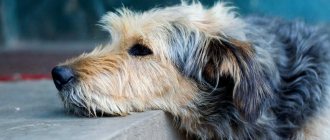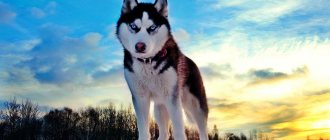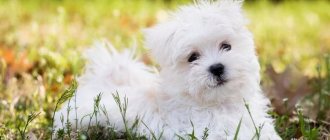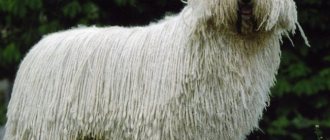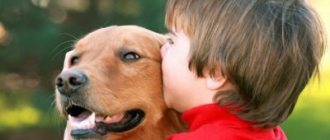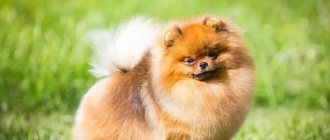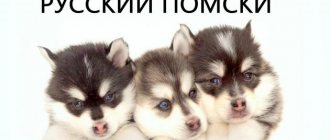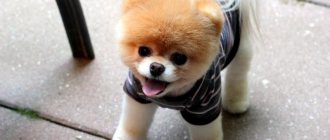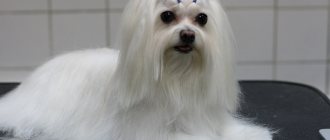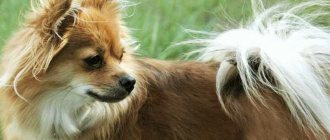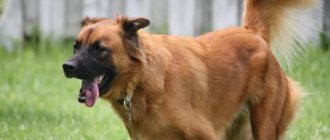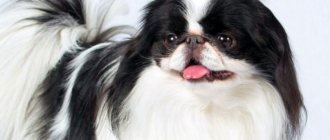Service dogs are characterized by large dimensions, a tough character and a subtle sense of smell. Such breeds are subject to requirements such as independence, fast learning, high intelligence and endurance. Some dogs are easy to care for and show resistance to harsh climatic conditions, so they do not require high financial costs.
South Russian Shepherd
The South Russian Shepherd is also one of the ancient breeds bred as shepherd's helpers. However, don’t be fooled by it – the dogs are just as ferocious and fearless as a German Shepherd or a Doberman Pinscher.
The dog can serve even in the harsh climatic conditions of the northern regions. Character traits include endurance, determination, and independence. Not popular among owners of country houses, since the dog's long hair requires careful grooming. Currently, it copes well with the duties of a livestock protector, and is also actively used in guard duty.
Types of service dog breeds
As mentioned above, a third of all breeds are classified as service breeds - this is about a hundred names. It is impossible to consider them all in detail within the framework of one article, so we classify them according to several criteria: by type of functional activity, by size.
Where do dogs serve?
Dogs are used in various types of service: police, drug control, customs, border service, security of sensitive facilities. Depending on the work for which dogs are used, they can be divided into the following groups:
- hunting;
- shepherds (guarding the herd, grazing livestock);
- watchmen (protection of residential and non-residential objects and territories);
- bodyguards;
- search (search for people, stolen property);
- customs dogs (search for money, prohibited substances, weapons);
- search and rescue (search for people in forests, mountains, in places of natural and man-made disasters);
- guard (protection of sensitive facilities and the state border);
- sledding (transportation of people and goods);
- bomb disposal dogs (search for explosives and explosive devices);
- therapeutic (canistherapy);
- guide dogs for blind people;
- assistance dogs for people with disabilities.
Saint Bernard
Saint Bernards are a prime example of dogs that can help a person out in almost any critical situation. Representatives of this breed have repeatedly risked their lives to save travelers in the Swiss Alps, who were literally buried under thick snow. Therefore, to this day, such dogs are used as rescuers.
Saint Bernards are one of the most devoted and faithful dogs, endowed with determination, perseverance, able to survive in harsh conditions, and also endure heavy loads. However, along with this, their character is not alien to good nature, cheerfulness and playfulness.
Pyrenean mountain dog
The Pyrenees Mountain Dog is a French breed; its ancestors are considered to be large dogs that in former times lived in Asia. Then this breed was used to guard gardens and protect livestock; currently the dog is actively used both for hunting and for monitoring herds on pastures .
The main character traits are autonomy, independence, and the ability to quickly respond to any changes in the situation. The movements convey elegance and pride.
Anatolian Shepherd
At one time, the Anatolian Shepherd lived in Asia Minor; it is an ancient breed of wolfhound. As a rule, such dogs are used to protect the herd from attacks by predators . The Anatolian Shepherd takes a responsible approach to its duties, especially in the absence of its owner. He has keen eyesight, so he likes to observe the territory from a hill.
This breed has strong jaws, so the shepherd's teeth are like a vice, it is difficult to unclench them until the dog itself wants it. The character is characterized by determination, agility, and quick reaction.
Read Breeds of long-eared dogs - top 20 rating
Kuvasz
The Kuvasz was developed in Hungary, just like the Hungarian Shepherd. Initially, representatives of this breed were used by the ancient Magyars to protect their homes from robbers and predatory animals. Since then, the character of the Kuvasz has remained virtually unchanged - it is still endowed with devotion to its owners, and is used, thanks to its keen sense, as a bloodhound . This dog has powerful muscles, long hair, is brave, does not know fatigue and is able to survive in harsh weather conditions.
East European Shepherd
The East European Shepherd is considered one of the large breeds of service dogs, often used in search and rescue services, but more often it is classified as a herding and cattle breed . It was developed in the Soviet Union, but has remained popular to this day.
He has great physical strength and a balanced character, thanks to which the dog is able to act quickly in critical conditions. The character shows independence and confidence, and the dog also has high intelligence.
Classification by animal size
Different breeds can serve people; the ability to help and be useful to a person does not depend on height and physique. Each variety has its own special characteristics that help dogs do the work assigned to them by humans.
Large breeds
These “large-sized pets” with their appearance speak about their purpose - security, protection and transportation of heavy loads. Impressive height, strong bones, strength and serious character are all characteristic features of these dog breeds.
Large service dogs – 25 breeds:
- German Shepherd
- East European Shepherd
- Central asian shepherd dog
- Caucasian Shepherd Dog
- South Russian Shepherd
- Anatolian Shepherd
- Romanian Carpathian Shepherd
- Romanian Shepherd Mioritic
- Kangal Shepherd
- Komondor
- Kuvasz
- Pyrenean mountain dog
- Estrela Mountain Dog
- Black Russian Terrier
- Cane Corso
- Neapolitan Mastiff
- Bullmastiff
- Saint Bernard
- Newfoundland
- Doberman
- American Staffordshire Terrier
- Rottweiler
- Giant Schnauzer
- Siberian Husky
- Alaskan Malamute
Important: among large dogs there are service breeds of dogs that can perform several types of service at once: guarding, herding livestock, being guide dogs.
Medium breeds
Compact, medium-sized service breeds are in no way inferior to their large relatives in intelligence, devotion and performance characteristics. They are also selflessly ready to protect a person and his property, and can become faithful assistants and the right hand of those in need of help. Dogs of this group are often used in customs affairs; they make good shepherds, hunters, sappers and guides.
Medium-sized service dogs – 24 breeds:
- Australian Shepherd
- White Swiss Shepherd
- Belgian Shepherd
- Border Collie
- Dutch Shepherd
- Collie
- Moody
- Picardy Shepherd
- Polish Lowland Sheepdog
- Polish Podgalian Shepherd Dog
- Portuguese Shepherd
- Bullets
- Pumi
- Old English Bobtail Sheepdog
- Croatian Shepherd
- Airedale
- Welsh Terrier
- Labrador Retriever
- Golden retriever
- German boxer
- Miniature Schnauzer
- Akita inu
- Shar Pei
- Schnauzer
Small breeds
This group includes the smallest breeds of service dogs. But, as they say, small but bold! All representatives of this group have excellent performance characteristics and are distinguished by loyalty and devotion to people.
List of small service dog breeds – 15 breeds:
- Bull Terrier
- Australian heeler
- Welsh Corgi Cardigan
- Welsh Corgi Pembroke
- American Miniature Shepherd
- Jack Russell Terrier
- Irish Glen of Imal Terrier
- German Hunting Terrier (Jagd Terrier)
- Parson Russell Terrier
- Czech Terrier
- Kerry Blue Terrier
- Scottish Terrier
- Miniature Schnauzer
- Miniature Pinscher (miniature pinscher)
- Dachshund
Important: in many sources you can find information that the Miniature Schnauzer is the smallest working dog breed. In fact, Miniature Pinschers are smaller than Miniature Schnauzers. Therefore, both dogs share the status of the smallest working dog breeds.
Cane Corso
The Cane Corso is one of the oldest dog breeds developed in Italy. They are distinguished by their ability to make decisions independently if their owners are in danger.
The dog showed himself well in guard duty . If it is important for you to have a friendly dog in your home who is patient with children, then you cannot find a better candidate. This breed is characterized by mobility, they are stubborn, easy to train and take their official duties responsibly.
Doberman
The Dobermann is one of the most common breeds developed in Germany. This is an energetic, physically strong, determined dog who is devoted to his owner, for whose safety he cares more than for his own life.
The Doberman is moderately aggressive, can think quickly and is fearless - almost no one can intimidate such a dog. If a dog notices danger, it will never warn of its intention to attack - it does it quickly, decisively and does not spare its own life. In the modern world it is used in the army and police .
TOP 60 service breeds
The following list describes the main characteristics of the most popular representatives of a large group called “service dogs”.
Australian Shepherd (Aussie)
The dog was selectively bred in the USA by crossing with different subbreeds of collie and Pyrenean Shepherd. Easily detects drugs. Suitable for keeping in the local area. Good-natured, easy to socialize.
Akita Inu
The Japanese dog breed was bred in the northern territories. It has a good undercoat and withstands bad weather conditions. Prone to aggression and attack, therefore, competent training and attentive upbringing are necessary. Requires long walks.
Alabai (Central Asian Shepherd)
People call it a “wolfhound dog”. A powerful torso, a developed jaw, a special disposition, which is emphasized by fearlessness - this is what characterizes the Alabaev. Does not get along well with other pets, and is devoted to a strict owner.
Alaskan Malamute
Sled dog for harness work. Symbol of the US state of Alaska. The body index is square, there is an external resemblance to huskies. The dog gets along well with other representatives of the Wolf family and works better in a pair or group.
American Staffordshire Terrier
Bred in England, USA. Smooth-haired, without undercoat. The body is muscular, the jaw is grasping and strong. The special landing makes it easy to make high jumps. The breed is prone to obesity and therefore requires long walks. The character is very complex.
English Mastiff
Refers to the old English mastiff dogs. Since ancient times it was considered the “enemy of thieves.” Used for guarding and baiting animals. The appearance is impressive. Large head, well-developed bones, pronounced muscles. Character with proper upbringing is good.
Dogo Argentino
The only breed bred in a South American country. At the beginning of the selection, it was intended for chasing large game in the jungle. Suitable for pack hunting of animals (puma, wild boar). Considered ideal for agility.
African Boerboel
A breed of dog from Africa of the mastiff group. Brought to South Africa and developed into a separate breed. It has an instant reaction and knocks you off your feet with lightning speed. Hunts an animal or follows a blood trail. They are recognized as particularly dangerous pets due to accidental attacks in the Russian Federation.
White Swiss Shepherd
Long-haired or short-haired representative of the “shepherd” group. Imported from the USA to Switzerland in 1966, received international recognition in 2003. All representatives of the breed are white in color with high-set ears. The character is accommodating.
Belgian Shepherd
They are considered reliable guards and shepherds. It is important to properly socialize to avoid aggression towards other pets. Can't stand being alone for long periods of time.
Bernese Mountain Dog
The dog was bred to transport goods and herd livestock. The color is typical with a combination of white, black and brown. Large body and head, muzzle is similar to a St. Bernard.
Beagle
They appeared in Great Britain, where rodents and game were hunted. Initially, they belonged to the hounds, but thanks to their particularly developed sense of smell, they are accepted into service in the police and customs. Does not require careful grooming.
Bloodhound
Known since the Middle Ages. Large, massive with a characteristic muzzle, distinguished by drooping ears and jowls. Excellent for police service in searching for objects and dangerous substances.
Bobtail
It is considered an Old English breed from Great Britain. The body format is square. Tolerates any weather conditions very well. Exercise and exercise are necessary to stay fit.
Boxer
Obtained through selection in Germany. Belongs to the Molossoid group. A powerful chest, strong limbs, a typical muzzle with an underbite, a strong grip - this is what distinguishes the dog from other similar breeds. They are stately, energetic, active. The police use them as bodyguards and security guards. In medicine - like a guide dog.
Border Collie
Belongs to the “shepherd dog” group. The main feature is the equal length of the muzzle and forehead. Physical characteristics and a special fit help develop greater speed when running.
Beauceron
It is considered rare and not very common. It vaguely resembles a Doberman, but with a larger torso. Characterized by stubbornness and perseverance, late maturation.
Briard
One of the popular dogs that perform tasks of searching for people, serving in the police as a guard and stalker. Complaisant character and innate intelligence are suitable for the rehabilitation of disabled people and sports competitions.
Bullmastiff
Obtained by crossing a mastiff and a bulldog. There is a black mask on the muzzle. A powerfully developed sternum, long limbs with overall compactness create an impressive impression. Used as a guard or companion dog. The psyche is very stable, he trains well.
Bull Terrier
Brought out in the 19th century. In Great Britain. Parenting requires rigor and attentiveness. You should train “for yourself” from an early age, and not get carried away with commands to take prey, pursue him, or detain him.
Welsh Corgi Cardigan
The herding dog is native to Wales. Known since the 10th century. The name "Corgi" comes from their small stature. With a long body, they have short limbs, which allows them to run at lightning speed, overcome small obstacles, and crawl into narrow spaces.
Pembroke Welsh Corgi
Unlike the corgi, it is slightly larger and more massive. Paws with pronounced angles, short. They run fast and require constant exercise. Shows security qualities and can block a criminal. Able to manifest itself while hunting small animals.
Hungarian Puli dog
Otherwise called “Hungarian water dog”. The appearance is similar to the commander. They are jokingly called “Rastafarians” because of the similarity with the hairstyles of representatives of the subculture. It is considered one of the most obedient herding breeds. As a service breed, it can search for explosives and dangerous substances.
East European Shepherd
The dog first appeared in the USSR to guard borders in the 30s. XX century The basis for selection was German Shepherds. They are distinguished by a more compact physique, less set limbs. Has a high degree of education and obedience.
Golden (golden) retriever
The breed was bred for the purpose of hunting game, following the blood trail of an animal. As breeding tasks expand, it is now suitable as a search dog, a guide dog, for medical purposes, and for detecting hazardous substances. There is no aggression in character, obedient, kind dogs with a beautiful golden color.
Doberman
A stately, slender dog with well-developed muscles, strong limbs and smooth coat. Difficult to train. Capable of jumping high and covering long distances. Does not react to stimuli when properly raised.
Caucasian Shepherd Dog
One of the ancient guard and herding breeds of the Caucasus. It is distinguished by its large size, thick undercoat with short center hairs, and capricious character. Can serve as a reliable defender of the territory. Shows aggression towards smaller animals.
Cane Corso
Representatives have been known since the times of gladiator fights. A powerful, strong, beautiful dog that goes fearlessly into battle. Copes with the tasks of defense and attack, grazing and guarding. The torso is developed, the coat is dense and smooth. Height up to 70 cm at the withers.
Kerry Blue Terrier
A breed of hunting dogs recognized as service dogs. Due to his advanced stalking skills, he can protect, search and track, which is used by the police and customs. Does not cause allergies. Hunting for rats and rodents is a natural instinct, which is emphasized by high intelligence.
Korean Jindo
High legs, dense coat with undercoat, medium size and excellent obedience distinguish this representative from other Asian breeds. It is not recommended to walk with others due to aggression. Loyal Chindos love their owner. They are not suitable for search work due to their curiosity and inability to concentrate on tasks.
Kurzhaar
The breed was bred for hunting, so the instincts of pursuit and scent are developed. They are considered weapon friendly and can withstand shots and explosions. Hardy and dexterous, they love water and swim well.
Labrador Retriever
A breed for hunting game. Gradually she gained popularity and became a companion dog. Works great in rehabilitation of disabled people, serves in medical care. They get along well with children, are friendly and responsible. A large, powerful torso helps withstand intense physical exertion. The height of the male dog is 57 cm.
Leonberger
They are considered guard and family pets with a rich undercoat. The size of an adult individual reaches 80 cm. Endurance helps to overcome any meteorological and geographical difficulties. They serve their family faithfully and are ready to attack.
Maremma Abruzzese Sheepdog
Italian Shepherd, bred for guarding and driving livestock. A distinctive feature is the similarity of the muzzle to a bear. The thick coat allows it to withstand weather conditions. The dog is very devoted to its owner. Tall growth (up to 70 cm) and developed limbs are adapted to overcome long distances.
Mastino napoletano
From the group of mastiffs with a height of up to 70 cm. Strong physique and leisurely behavior are expressed. Excellent security qualities are used for protection purposes. A serious dog that requires proper training and strictness.
Miniature Schnauzer
A medium-sized representative of the group of schnauzers that are suitable for hunting. It is considered a hypoallergenic, hunting, service dog. Can guard and pursue. Gets along well with other pets, obedient.
Moscow guard dog
Brought to the USSR for security purposes. The coat is thick, dense, with long awns and rich undercoat. Suitable as a protector for children and adults. The character is complex, but with proper training it performs excellent service.
Moody
The herding dog comes from Hungary and is somewhat reminiscent of the Siberian husky. A good sense of smell is a reason for service in customs, police, and the Ministry of Emergency Situations. Very energetic and resilient.
German Shepherd
One of the few who is distinguished by high intelligence. Bred in Germany for security and other service purposes. Well-developed muscles, typical posture suitable for attacking, jumping, and long pursuits. A faithful dog who is devoted to his owner and family. May show aggression.
Newfoundland
Bred in Canada as a working pet for mountainous areas as a shepherd's assistant and livestock guard. In the Russian Federation the breed is called “diver”. The black, thick undercoat allows it to withstand bad weather. He listens to his owner and easily learns commands.
Pyrenean mountain dog
A breed with natural qualities as an excellent protector of home and territory. Amenable to training, but with persistence in education.
Pumi
Hungarian companion dog, bred to accompany and guard livestock. Size is medium. The coat is very thick. The breed is naturally curly, so it is necessary to groom it. Can jump high and run fast, follows learned commands. Obedient and devoted.
Giant Schnauzer
In intelligence it is not inferior to the German Shepherd. Tall growth, docile nature, typical muzzle distinguishes it from other breeds. Well trained. Originally she was a shepherd dog. Today he performs security functions.
Rhodesian Ridgeback
Appeared in Africa to hunt elephants and then to guard slaves. A strip of fur runs along the back, where the hair grows in the opposite direction. A hardy, strong large dog that quickly overcomes obstacles, hunts and protects its owner.
Rottweiler
German service dog breed, bred specifically for protection. A very large torso and massive paws, quick reaction, and instant grip make her an excellent watchdog. Difficult to train.
Black Russian Terrier
Bred in the USSR by crossing different breeds of service dogs. The main task is security and protection. Very tall stature and long limbs make the pet capable of jumping, running and chasing. He trains well, serves in the Ministry of Internal Affairs and medicine.
Samoyed dog
An ancient (primitive) breed for harness racing, transporting goods and people. Hardy, powerful and strong with thick white fur. Friendly to people and children, affectionate with the owner.
Saint Bernard
They serve as guards and assist in rescue in difficult conditions. They are obedient, can withstand loads, and are devoted to their owner. They are easy to train and are determined to protect their territory. The breed is very large in size. The dog requires special care for its coat.
Siberian Husky
From the “sledding breeds” group, which can be used as a hunting breed. Nowadays it is “fashionable” for breeding due to its attractive external features. They are difficult to raise. Perseverance and patience in the owner's character are required.
Scottish Terrier
The Scottish Terrier is small in stature with a very courageous character. Originally bred for hunting small game. Due to the increased level of smell, it can quickly search for objects, pursue and seek out prey. Depends on the owner, the dog is ready to follow him everywhere.
Thai Ridgeback
The breed is completely hypoallergenic and does not require trimming or combing. Good-natured, friendly to children, does not try to dominate. He is highly intelligent and eager to learn new things. Size no more than 50 cm.
Tibetan mastiff
One of the most impressive and representative of dogs, whose size is enormous. For males, the height is 66 cm and above. Weight can exceed 80 kg. Bred as mountain dogs for guard purposes. They stay awake at night and are excellent watchdog and security pets.
Bouvier des Flanders
Bred for guarding and grazing livestock. The size is large. Due to their developed physical characteristics, they can travel long distances. They listen well and follow commands. Positively disposed to friendship with other pets.
Hovawart
Its height is up to 70 cm, its strong build, and its strong protective qualities make it irreplaceable as a companion dog. The breed is actively used in the police service to search for objects and people. The character is persistent.
Miniature Schnauzer
A small representative of the Schnauzer, which was bred for hunting. Now used as a search dog. The courageous nature and restless disposition are what make this breed attractive to those who love activity.
Sheltie
Well trained and easy to raise. Its small stature and beautiful coat captivates dog lovers. Extraordinarily light, playful, jumping and fast - an ideal breed for sports performances and rehabilitation.
Schipperke
Belgian representative of small watchdogs. This is a mini version of the Belgian Shepherd. High intelligence, loves to engage with the owner, obediently follows commands, stands up to protect the home and family.
Scottish Sheepdog (Collie)
Originally bred as a shepherd. Subsequently, security qualities, skills in searching for the missing, and following the trail began to develop. Today they are increasingly turning into a decorative breed due to their very beautiful, noble appearance.
Entlebucher Mountain Dog
A small representative of Sennenhunds with a characteristic color and smooth coat. An active, cheerful breed, quickly learns commands, can be trained, and performs in competitions. The average size allows you to keep it in an apartment.
Airedale
The hair is hard, curly, with undercoat, which requires grooming. Strong, stately build. They serve as guards and are able to search and detect objects. He is well trained and ready for long walks.
Black Russian Terrier
Dogs of this breed are distinguished by excellent health and physical strength. Distinctive features also include devotion to owners, good immunity and energy.
The Black Russian Terrier is highly trainable, able to quickly carry out any commands, and has a stable psyche. Such dogs are very observant and can notice something is wrong at a great distance; they never attack without warning - they initially take a fighting stance and emit a long roar. They do not trust strangers, have a quick reaction and are able to reach high speeds, and are used primarily in search and rescue services .
The role and distinctive features of service dogs
Historically, the list of service breeds is expanding. Now it includes those who have not only protective properties, but also a subtle sense of smell, special natural intuition, genetic skills.
The main features of the breeds are as follows:
- Well amenable to training. Follows commands using voice and gestures due to a high degree of learning ability.
- They quickly come into contact with people and have special devotion to their owner.
- Depending on the breed, they perform assigned tasks: protection, assistance, rescue, detection, pursuit.
- Most breeds have complex personalities. When raising, it is necessary to show masculinity.
- They differ in their need for long walks and physical activity.
All service dogs are distinguished by their endurance and are able to quickly learn new things.
Akita Inu
A Japanese breed specially bred for hunting big game. The Akita Inu is a hereditary service dog with impressive size, strong legs and a stubborn character.
Such dogs independently assess the situation and decide exactly what they should do; they have good immunity and high intelligence. They are aggressive towards any stranger, but never attack prematurely. This breed is actively used in the search service .
Read List of the best cartoons about dogs - TOP 50
Standards
Working dog breeds have the following characteristics:
- These are quite large, strong and very hardy animals.
- They are adapted to cover long distances.
- Service dogs have an innate need to protect their owner and his belongings.
- They have good intelligence and ability to train.
- Such dogs should not be overly aggressive. Their behavior is usually calm and balanced.
The man began to use the dog for work purposes as soon as he tamed it. In the beginning, the main work for animals was hunting and guarding livestock. Now the range of functions that service dogs perform has expanded significantly. That is why breeds are now divided into several groups, which characterize their abilities and suitability for a particular task.
- Sled breeds are usually found in snowy parts of the world, where dogs are usually harnessed to sleds. The average weight of the load on a dog is about 50 kg, and the speed it can develop ranges from 15 to 20 kilometers per hour.
There is no need to talk about the huge role of sled dogs in our lives, because probably everyone knows the story of a real-life dog named Balto. When an epidemic of a dangerous disease broke out in Alaska, all the victims needed medicines delivered by air. However, weather conditions prevented the planes from taking off, and then the mission to deliver medicine fell on a dog sled, which did an excellent job, thus saving hundreds of lives.
- Guard and search dogs serve in the police, anti-terrorist organizations and drug control. They find and catch dangerous criminals, protect state territory, help the border patrol, serve in the army, work with customs officers and airport employees, find prohibited substances, and protect objects of national importance.
- Breeds belonging to the sporting group are most often short-haired and smart dogs. They are used in rescue services: fire, water, mountain. Representatives of the sports group also help the blind and other people with disabilities.
Bullmastiff
The bullmastiff's menacing appearance hides a reliable companion and loyal friend. The character of representatives of this breed is characterized by such qualities as fearlessness, loyalty, the ability to quickly carry out commands, and hard work.
The bullmastiff was first bred in Great Britain at the end of the 19th century, and is currently actively used in police service . The popularity of such dogs also spread to Sweden and Norway, where the dogs were introduced to military service.
Central asian shepherd dog
The Central Asian Shepherd is actively used in guard duty . Such a dog has a pronounced devotion to the owner and tries to show this every time the opportunity arises. The Central Asian Shepherd is unpretentious in care and is accustomed to survive in the harshest climatic conditions.
Among the character traits, independence, speed of reaction, calmness and composure prevail, so such a dog will think several times before doing anything. In order for an adult dog to act impeccably in a critical situation, it is necessary to raise a Central Asian Shepherd from childhood.
Hungarian Shepherd
The Hungarian Shepherd is one of the largest dog breeds, most often used in guard duty . By nature, the Komondor (the second name of the breed) is endowed not only with intelligence, but also with cunning, so you definitely won’t get bored with such a dog.
Distinctive features include quick learning, vigilance, and the ability to immediately respond in a critical situation. The Hungarian Shepherd loves to periodically patrol the territory, because this is inherent in the dog at the genetic level.
The most popular breeds of service dogs
We talked about different types of service dogs, found out what work service dogs do and how they help people. Now let's try to make our TOP popular breeds that are most often used in the service.
TOP popular service breeds:
- German Shepherd. These versatile dogs top all popularity lists. Smart, quick-witted, easy to train, loyal, brave and determined - all this is about them! Shepherd dogs are used to guard the state border, in customs, in the police, in guard service, to guard various objects, in canitherapy, and as guide dogs. Any job offered by a person is within the power of the Germans. If you need to herd livestock, shepherd dogs will remember their historical purpose. You can safely leave your kids with them; they will be affectionate and patient nannies. But intruders who try to attack the owner or enter the territory guarded by the shepherd will not be happy!
- Rottweiler. The ideal watchman and bodyguard are characterized by lightning-fast reactions and boundless courage. No one has ever escaped from such a pursuer!
- Doberman. The gracefully built dog perfectly adapted to the role of a policeman, rescuer and personal bodyguard. He has all the qualities that are important in these activities. Dobermans are decisive and have quick reactions.
- Giant Schnauzer. These dogs are often hired by the police, customs and airports. Dogs have a unique sense of smell and can easily detect contraband, illegal substances and illegal migrants.
- Black Russian Terrier. The breed is the pride of our country and was originally bred for harsh service at secret military facilities.
- Saint Bernard One of the largest breeds of dogs is most often used in search and rescue operations. However, this does not prevent them from playing the role of nannies, accompanying people with disabilities and guarding houses.
- Belgian Shepherd. Of course, dogs are excellent shepherds, but in modern realities they have no equal in sports activities. Belgians are willing to spend hours training and learning new tricks.
- Cane Corso. There is no need to guess for a long time about the occupation of this dog - it’s obvious! Giants of Italian origin are ideal guards and watchmen. In addition to their outstanding physical characteristics, Cane Corsos are distinguished by their incredible intelligence.
- German boxer. Another bodyguard. In America, these dogs are among the top ten service breeds. Dogs are also popular in our country.
- Newfoundland. Large dogs do an excellent job as guards of private property.
- Labrador Retriever. When people talk about guide dogs, they most often remember Labradors. The dogs are easy to train, have great endurance and patience, and are not at all aggressive. All these qualities make them ideal assistants for blind and visually impaired people.
- Golden retriever. Another breed that is successfully used to work with people with disabilities. Like Labradors, golden retrievers are also used in various types of canistherapy.
- Miniature Schnauzer. It is no coincidence that we included these cheerful bearded dogs into small working dog breeds. In the blood of “bearded men” there is a desire to protect everything around: the owner, his children, household property. They do this energetically and decisively. Miniatures don't understand that they are small, so they behave like big dogs. And although we wrote above that we do not agree that a small dog is the smallest service dog breed, they provide impeccable security!
- Caucasian Shepherd Dog. This giant doesn’t need to imagine himself as a big dog - that’s what he is. This is an excellent security guard, scaring away intruders with just its appearance.
- Central Asian Shepherd Dog (Alabai). Another generally recognized watchman and home guard. No one in a sober mind would dare to enter the territory guarded by the Alabai.
- Bullets. Hungarian breed of shepherd dog. Because no one knows how to deal with sheep with bullets! They dashingly jump on the backs of animals and drive them in the right direction. Those who do not obey are bitten on the limbs by bullets.
- Commander. Shepherd dog from Hungary. Their impressive size and thick coat, consisting of dense dreadlocks, allow the dogs to protect flocks from wolves and other wild predators. Such a fur coat is too tough for them!
The owner of a dog belonging to a service breed must fully understand his responsibility. A number of performance characteristics of such pets can be dangerous to others, in the absence of proper education and special training. Dogs need to be trained from a very early age, teaching them obedience and strict execution of commands given by the owner.
Belgian Shepherd
The Belgian Shepherd is often used in investigative activities, but is also good as a shepherd's companion . There are four varieties: Groenendael, Malinois, Tervuren, Laekenois.
The dog’s natural ingenuity, high intelligence and good memory allow the owner to take him hunting with him. This breed is highly trainable and has excellent intuition, so if your pet is wary of a stranger, you should listen to him.
Giant Schnauzer
Another breed bred in Germany. Self-confidence can be traced in the character of Giant Schnauzers; they are extremely active and courageous. It will not be difficult for owners to teach their dog something new, since representatives of this breed quickly grasp information and remember it. Primarily used as a bloodhound and classified as a police working dog .
How to choose the right service dog
Unlike decorative breeds, buying a service dog is a serious step. It is necessary to weigh all the positive and negative aspects and characteristics. You need to know these factors:
- information about the nursery, breeder, history of selection selection;
- buy a puppy with documents, initial vaccinations and after examination by a veterinarian;
- information about the positive and negative aspects of the future pet.
It is imperative to exclude the presence of hind limb dysplasia and genetic culling. No matter how attractive the terms of purchase may seem, you should not purchase a dog that is known to be sick.
Caucasian Shepherd Dog
As many dog experts believe, the Caucasian Shepherd is one of the best working dog breeds. The appearance of a dog can already make you wary. The Caucasian Shepherd is characterized by such qualities as determination, courage, independence and incredible physical strength. The dog also has high intelligence and extraordinary devotion to its owners. The Caucasian Shepherd acts immediately in the event of a critical situation - without warning, it is capable of resolutely attacking.
Read The best dogs for children - top 20 breeds
Many owners value the shepherd dog for its ability to make decisions independently. However, to keep a dog you will need a spacious enclosure and, preferably, a chain, since representatives of such a powerful breed can sometimes be almost uncontrollable. The dog is used primarily in police service, but during the Great Patriotic War the shepherd dog showed how well it copes as a “squire.” Representatives of this breed have been used more than once as sappers .
German Shepherd
The German Shepherd has high intelligence and a balanced character, as well as discrimination - the dog is able to instinctively determine whether a particular person can be trusted.
A distinctive feature of the breed is that the dog knows how to work in a team, so sometimes the dog does not need to explain what exactly needs to be done - he will guess on his own. The dog is hardy, physically strong and has a pronounced intuition, which is why it is often used for official investigative activities . He treats his owner's family members extremely friendly, and considers it necessary to keep strangers under constant control.
Features of caring for service dogs
Proper maintenance of your four-legged friend is the key to maintaining the effectiveness of his professional qualities and performance, especially when it comes to service dogs. Of course, in specialized institutions and guard services there are whole regulations for the care of working dogs. To keep a dog at home, it is very important to develop a regular regimen of feeding, walking, training and other physical activities.
For your information! It is believed that only half of a service dog's special qualities can be achieved through training, the rest is achieved through proper care of the dog, regular positive interactions with family members and having an authoritative owner whose will will be paramount to the dog.
By investing time and energy in your pet, you can get the most loyal and reliable friend for many years. A service dog can protect and even save the life of an owner who has earned its respect.
Boxer
The Boxer was developed in Germany and is one of the most common breeds. The dog has proven itself excellent as a bodyguard , and is currently used in guard duty . In appearance, such dogs seem obstinate, but in fact they are ready to obey any word of the owner, with “their own” they are flexible, quickly remember commands and learn new things.
The boxer loves regular physical exercise, and he will only enjoy daily training in a playful way. Sensitive to low temperatures, does not like damp and chilly weather.
Alabai
The second name of the breed is Central Asian Shepherd. This is one of the oldest and very large dogs, reaching 65-70 cm at the withers.
If anyone thinks that the Alabai was bred as a fighting dog, then he is completely wrong. This is a guard and herding dog, with a fairly calm disposition and independent character.
Its dimensions allow the Alabai to be a fearless dog, but it is not inclined to rush at anyone first. He will simply warn, and if this does not have an effect, measures will be taken.
All the legendary aggression of the breed is the fault of careless owners who place the priority not on the dog’s performance qualities, but on its capabilities. Also, the dog is very touchy and even vindictive, so punishing him is the same as cutting off the branch on which you are sitting.
Training must be approached wisely, since the Alabai will not follow orders like a robot: he needs to convey the need for certain actions. Therefore, training should begin almost from the very birth of the puppy. And if you cannot provide your dog with a decent upbringing, it is better to entrust it to a professional, since “three classes of parish” is not for such a serious breed.
Video: alabai
Rottweiler
The Rottweiler is a breed of dog specially bred in Germany for service purposes. Distinctive features are hard work, physical strength, endurance, and increased aggressiveness.
Rottweilers have excellent health, quickly become attached to their owners, act deliberately, but try not to let strangers get close to them. They are mainly used in search activities; currently, representatives of this breed often serve in the army or police.
American Staffordshire Terrier
The American Terrier is an independent and rather proud breed, whose representatives are not used to accepting everyone, so their trust must be earned. He is distinguished by excellent health, strong immunity, lively character, fearlessness and hard work. American Terriers quickly become attached to their owners and are ready to follow any of their instructions, so they are easy to train, but they must be constantly trained, otherwise they lose their skills. They can be aggressive towards other dogs.
They are used primarily for protective guard duty , but recently breeders have been trying to make the breed more “domestic”. Previously, American terriers participated in dog fights, and also protected the lives of farmers in the troubled times of the 30s of the last century in the United States.
Types of dog training.
Who among us did not dream of a dog as a child? And now your dream has come true, you have a puppy. But who could imagine that along with pleasure the burden of responsibility for a living being would fall on you. It turns out that a puppy needs to be raised properly, fed and educated properly. You immediately faced a lot of difficulties that you could not even imagine. It turns out that your four-legged friend requires extra attention as a puppy; he is just like a child. Many owners, when getting a four-legged pet, have trouble imagining life together with a rapidly growing dog. Some are sure that with age the dog will become smarter and understand everything itself, some put off training “for later”, and others (usually owners of decorative dog breeds) believe that their pet does not need training. But even a tiny Yorkie can become a formidable tyrant and keep the whole family in fear. As a result of such reasoning, the life together of the owner and the dog turns into a nightmare. Let's try to figure out together how to make your life and the life of your pet as comfortable and enjoyable as possible for both. First, we need to decide what we expect from our dog. For some, it is enough for the dog to come when called, while others need a dog that vigilantly guards the owner and his household. There is nothing better than an obedient dog who looks you in the eyes and almost asks: “master, tell me, ask for anything - I will do everything for you.” And to do this you just need to establish a dialogue with your friend. It is not enough to buy expensive food and ammunition for him. You need to understand the dog, at least try. In our turbulent time of super speeds, there is less and less time for this. There is no time for your dog, but she is growing and developing her own character. This is where disagreements and misunderstandings arise with your friend.
In nature, puppies are raised by their mother. Having taken the puppy into the house, the owner takes on this responsibility. The puppy needs to be taught how to behave at home and in public places, and this must be done carefully enough so as not to traumatize the delicate psyche. As the child grows up, he may try to do something forbidden in order to check whether the owner’s requirements have changed, and here the owners will need to show firmness and consistency.
In any case, you can’t do without a general training course. OKD is needed to develop discipline in a dog; in the process of joint training, contact between the owner and the dog is established, OKD is the basis for further training of the dog in any training course. But to achieve results, you need to understand how, when and how much to exercise with your dog. trainer can help with this , who will suggest a training regimen and methods of influence that are suitable for a particular dog. Choosing an instructor is not an easy task and you need to take it seriously, since a spoiled dog can cause a lot of trouble for both the owner and those around him. Nowadays, the media is flooded with offers for dog training . It is difficult for a beginner to understand the flow of information, but following some simple rules will significantly reduce the list of candidates for the role of your pet’s teacher. What should you pay attention to when choosing a dog trainer? Among the most significant points, the following can be noted: the dog handler’s education, work experience, experience working with this breed of dog. It would be good if, before choosing one of the instructors, you looked at the work of the dogs trained by him. If possible, it is advisable to observe the instructor’s classes with other dogs and hear the opinions of other dog owners with whom the trainer works.
When choosing a trainer, pay attention to his working methods. His work should not be based on painful methods, since it is impossible to teach a dog anything using only punishment.
Price options for dog training services are now also quite extensive, but you need to understand that the services of a professional dog handler with a decent amount of work experience will not cost you cheap. But even the high cost does not guarantee that the instructor has the proper experience and will not spoil the dog. Therefore, you should not opt for the first trainer; you need to compare several candidates, evaluate their methods of working with dogs, customer reviews, and only then make your final choice.
But now the dog trainer has been selected and you are ready to start training. Now you are faced with the question - which training course to choose? There are many different types of training available, and it is best to choose the course that best suits your dog's breed, i.e. why these dogs were bred for. It is a mistake to believe that decorative breeds were bred to lie on the couch all day. In fact, if a dog is healthy, then its highest happiness is joint activities with its beloved owner.
Let's try to understand the existing training courses and what each of them is. I would like to immediately make a reservation that such training standards as “saboteur”, “bodyguard dog” and the like do not exist in the domestic official cynology, but they were created by enterprising “trainers” to attract inexperienced clients.
But let’s take a closer look at the officially existing types of training .
OKD (general training course).
In the process of OKD, the dog develops skills that discipline the animal, allowing it to control its behavior in the process of everyday handling and in practical activities. OKD includes training the dog to show its dental system, to have a calm attitude towards the muzzle, to go into a free state (the “Walk” command), to refuse food (the prohibitive command “Fu”), to fetch, return to its place, and to approach the trainer (the “Come to me” command). "), stance, landing, laying down, movement of the dog next to the trainer, overcoming obstacles, calm attitude towards shots.
ZKS (protective guard service).
In modern conditions, in the power structures of Russia, on the basis of the skills of the ZKS, search dogs, guard dogs, sentry dogs, and escort dogs are trained. This course is called a special training course and includes an extensive training program in accordance with the future use of the dog.
The result of the time and effort spent on the ZKS is a well-trained dog that, quite possibly, will one day save your life or property. She will adequately and correctly perceive strangers, and you will always know how she will behave in any situation. If you have a private house, then it is difficult to find a more faithful and sensitive watchman. And in the evenings you can calmly walk with her wherever you want. A dog trained in the ZKS course must have the following skills: find objects with a certain smell; detain a fleeing person; protect the owner from attack; protect things and property; refuse food offered by strangers; treat shots and sharp sounds calmly; be able to lead a person under escort.
Search service.
Search dogs are used to detain, protect violators, search areas and premises to detect a person and his objects, as well as to identify a person by his smell. In particular, such dogs are able to find a person by his scent trail from a minute to several hours ago over tens of kilometers in any climatic and geographical conditions.
The dogs of the search service develop the following skills: distrustful, malicious attitude towards strangers, detention, protection, escorting violators and protecting the trainer; searching for a person by his scent trail and selecting a person from the trail; search of the area and premises; sampling things by the smell of a person and sampling a person by the smell of his thing; guarding in place and on the move; protection of things.
The best dog for search service is the German Shepherd, which works flawlessly in various conditions. In addition, breeds such as Airedale Terrier, Giant Schnauzer, Boxer, Doberman and some others are also suitable for search service. However, when choosing a breed, it is always necessary to take into account the climatic conditions of the places where the dog is planned to be used.
Russian ring. Big ring.
“Russian Ring” is a sport with service and sports dogs in complex protective service, in which the dog independently works against one, two, or three defendants. The “Big Ring” differs little from the “Russian Ring” and also represents the championship of trainers with dogs according to the complicated standards of protective services. The “Big Ring” competition is a championship between trainers and dogs according to complex standards of protective services. The sporting goals of the “Big Ring” are to reveal: the skill of dogs, the quality of their training, the abilities of the trainer and, above all, the innate qualities of the dog. I. RUSSIAN RING
"Russian Ring" is a sport with service and sports dogs in a complex protective service. The Russian Ring places very high demands on the dog’s protective qualities, its strength of character and mental stability. In this case, it is preferable to have dogs that are active, courageous, attacking, working in a liberated manner, withstanding pressure from the helper and must be controlled. Competitions are held to identify the strongest pairs of trainers and dogs.
Competitors perform four exercises: test of obedience; protection from one attacker; defense against two attackers; defense against three attackers.
Ore prospecting and gas prospecting service.
The customs service uses canine dogs to search for narcotic drugs when participants in foreign economic activity move goods and vehicles across the customs border. The main breeds used here are: German Shepherd, Labrador, Spaniel. Small dogs such as spaniels are used when inspecting small spaces. Buses, cars, sometimes railway trains, in particular compartment cars. Since a small dog does not cause a feeling of fear in the person being searched. If you shout at a spaniel while working, she may completely refuse to continue working, but the shepherd dog is quite persistent and will continue to work no matter what. The Labrador may be offended, but he will continue. There is a misconception that dogs are trained to detect drugs using real drugs. This is wrong. They use substances with organoleptic properties similar to drugs. And they do not affect dogs, just like humans. Such dogs serve in customs for 8-9 years, after which they are retired, they become civilians and live with a family.
IPO is an international testing procedure for working dogs.
IPO (Vielseitigkeitsprufung fur Gebrauchshunde nach International Prufungsordnung) is a three-level test for service dogs approved by the FCI. IPO is divided into 3 stages - I, II and III, gradually becoming more complex. These grades include Tracking (Section A), Obedience (Section B) and Owner Protection (Section C). Recently, it has become increasingly widespread, despite the rather long course of classes. It requires exceptional training of instructors, the presence of special gear and equipment for the protective section and the “obedience” section is mandatory, while the “track work” section requires the presence of sufficiently large free areas. This course is intended for dogs that have great prospects for growth in their show career or owners who are more interested in foreign training.
IPO includes the following skills: 1) tracking work, 2) obedience course, including the movement of the dog next to the owner on a leash and without a leash, boarding and laying the dog in motion with the owner moving away from the dog, endurance, bringing an object (fetching ) in combination with overcoming the barrier, 3) protective service, including detention, protection, warning and escort of the offender, detention of the offender when attacking a dog. The number of classes depends on the dog’s preparedness. Service dogs are accepted, preferably from 3-4 months. The mandatory requirement for the dog to perform all the skills of the course in a fun and fast manner ensures that they are entertaining and outwardly more sporting in nature compared to domestic standards. An IPO Diploma is required for a number of dog breeds that have a working class at CACIB shows.
Schutzhund (protection dog).
Schutzhundeprufung is the German national training system. This type of training appeared in Germany in 1900, as a test of the service qualities of German shepherds. However, by the middle of the 20th century, the Schutzhund moved from official service to sports. Any breed of dog can undergo Schutzhund training, but German Shepherds are most often trained. Schutzhund is divided into three difficulty classes.
Mondioring.
French sports training system. The word translates as “broad, varied” and consists of a large number of elements, complexly arranged together. The dog is tested for agility, courage, intelligence, and is required to act automatically. All elements of mondjoring are divided into three degrees of difficulty. Competitions are held in Europe and America. Its style resembles a lightweight version of OKD. Mondioring was developed by delegates from several countries in Europe and America in the hope that it could become a link between the various existing national training programs and allow a fruitful association of all service dog enthusiasts, both beginners and experienced dog handlers. Mondioring should be: fun for the spectators; for participants - a sports game with a gradual increase in difficulty level; for training enthusiasts – a sport with competitions.
To practice mondjoring, you need a fenced area equipped with various items and one or two participants in protective suits who will be partners with dogs, handlers and judges, who at the competition must determine the best in accordance with the rules. The purpose of mondjoring is to identify the dog’s abilities, the level of its training, the skill of the handler and, most importantly, the dog’s gene pool.
The program consists of three types of exercises, which must be performed in the following sequence: obedience exercises, jumping exercises, grip exercises.
Obidience.
General disciplinary dog training. Obidiense is a variant of the international dog obedience rules adopted by the FCI. Very similar to OKD, but with slight differences in the dog’s execution of commands. A special feature of this course is complicated options for fetching and controlling the dog’s movements at a distance, and precise work in tandem with a person. This course is intended for owners who are more interested in foreign training for a future sports career. Obedience includes the following skills: Moving side by side without a leash with changes in pace and direction, long exposures in a lying and sitting position in a group of dogs, sitting, laying and standing a dog in motion with the owner moving away from the dog, sending in the indicated direction, presenting an object ( wooden and iron), overcoming the athletics barrier, selecting “your” thing. The number of classes depends on the dog’s preparedness. Dogs of all breeds and ages are accepted.
Agility.
Perhaps one of the most fun sports for dogs of their owners. This English word can be literally translated as: mobility, agility, dexterity, speed, liveliness and agility. Agility owes its appearance to the Englishmen Johnny Varley and Peter Meanwell. The goal of agility is for a dog to overcome all obstacles under the control of an athlete (handler) in the shortest possible time. At the same time, the order of overcoming them is indicated on special plates. Dogs of any breed can train in the agility program and take part in competitions . This type of training is very different from such as OKD or ZKS. Agility is perceived by the dog more as fun and active fun than as complex training that requires the concentration of all capabilities.
But you shouldn’t think that everything in agility is simple and easy. The dog's activity and intelligence are clearly not enough. Agility is, first of all, a harmonious combination of good communication between the handler and his ward. In addition to mutual understanding with the person, the dog must show the maximum level of attention: quickly and accurately understand every movement of the person; do not pay attention to external stimuli (noise and strangers). The most important thing in agility is to quickly and without mistakes run through all the obstacles along the way. Another common name for obstacles is projectiles. In total, there are two main types of projectiles: contact and non-contact. An important requirement of agility is that the dog overcomes all the projectiles independently. The handler can only control with gestures and voice commands. Physical contact with the dog and the equipment is strictly prohibited, as is the use of a leash and collar. The task is further complicated by the fact that the handler is prohibited from using sugar, pieces of food or other treats. Agility is designed for speedy dogs of various breeds, from small to large dog breeds.
Waitpulling.
Demonstration of the dog's drafting power is an IWPA (Working Dog Owners Association of America) standard. A sport intended for dogs whose owners want to develop the strength and endurance of their quadruple pet. This is a training according to the rules of which the dog must drag a load that is located on a platform over a distance of 3-5 meters. At competitions, the weight of the load that the dog was able to drag and the speed of dragging are taken into account. Good dogs can carry more than 23 times their own weight.
Freestyle.
Dancing with a dog is a sport intended for owners who want to teach their dog to “hear” music and be able to perform difficult dance steps to it. Freestyle is a sports training, according to the rules of which the owner and his dog must perform a dance to music. The owner chooses the music himself. When evaluating a dance, the complexity of the elements, the dog's interest and the overall impression are taken into account.
Recently, many organizations have been offering clients such training courses as UGS (controlled city dog) and ZGS (protective city dog). The emergence of UGS and LSS standards was dictated by the development of domestic dog breeding, the emergence of the need to focus on a user rather than a sports training system, more suitable for ordinary amateur dog breeders. The standards of the UGS and ZGS ensure the education of a controlled dog that is not dangerous to others, adapted to urban conditions and capable of protecting the owner if necessary. The standards are less regulated in relation to the behavior of the dog and its owner compared to OKD and ZKS, and do not provide for a score for the performance of skills. Testing the development of a skill is carried out on a pass-fail basis. Skills that are secondary from the point of view of urban dog keeping, such as bringing an object, returning to a place, executing a set of commands, selecting an item by smell, guarding an item, guarding and escorting an intruder, have been eliminated or significantly simplified. Most skills are tested on a leash. UGS includes the following skills: 1) moving next to the trainer (on a leash and without a leash), 2) calling the dog (the command “Come to me!”), 3) performing the commands “Sit”, “Lie down” near the owner and at a distance . Holding in these positions with the owner leaving the dog at various distances, 4) performing the commands “Lie down” or “Sit” while walking the dog, 5) holding the dog for a long time in one place with the possibility of the owner leaving the dog’s field of view 6) training the dog to muzzle, both in a free state and while moving on the command “Nearby”, 7) weaning the dog from picking up from the ground, accustoming the dog to city noise - gunshots, umbrellas, various sharp sounds. LHS includes the following skills: 1) obedience of the dog in the event of a large crowd of people who are not aggressive towards the owner, 2) protection of the owner from the “intruder” with a warning in a place where a large number of people gather, 3) protection of the owner from the “intruder” in case of a sudden attack and frontal attack.
Holding in these positions with the owner leaving the dog at various distances, 4) performing the commands “Lie down” or “Sit” while walking the dog, 5) holding the dog for a long time in one place with the possibility of the owner leaving the dog’s field of view 6) training the dog to muzzle, both in a free state and while moving on the command “Nearby”, 7) weaning the dog from picking up from the ground, accustoming the dog to city noise - gunshots, umbrellas, various sharp sounds. LHS includes the following skills: 1) obedience of the dog in the event of a large crowd of people who are not aggressive towards the owner, 2) protection of the owner from the “intruder” with a warning in a place where a large number of people gather, 3) protection of the owner from the “intruder” in case of a sudden attack and frontal attack.
UGS and UGS courses may be more preferable for owners of dogs of non-service breeds, as well as for dogs of decorative breeds (UGS course).
It’s up to you to decide which training to give preference to when training a dog—user dog or sport dog; each dog has enough opponents and defenders. I would just like to note that custom training is aimed, first of all, at creating a well-mannered dog that is at the same time always capable of defending its owner. These types of training were used to train dogs for various services of the former USSR and they proved their effectiveness through many years of practical use. Disadvantages include the heavy burden on the owner and dog during training and the requirement for unconditional obedience of the pet. But the effort is worth it - you can be sure that the dog will not let you down at a dangerous moment.
As for sports training, these are, first of all, Western teaching methods. For the most part, these are complex training systems, that is, they include both obedience and protection, and, sometimes, tracking work. In them, learning is based on fundamentally different positions, namely, on a playful form of learning and positive motivation, which is their advantage, because in this case, the dog works actively and with a clear interest in learning. However, it is very difficult to achieve stable and precise work of the dog “on the street”.
Next article in the section...
